Time to Read: 12 minutes
This is a transcript from the Value Hearing YouTube Channel. In this video, audiologist Emma Russell gives you some great tips on how to clean and care for your hearing aids.
Be sure to like, subscribe, comment and share our videos. It means you don’t miss a new video and you help our channel grow to reach more people with timely independent advice.
Hi there, I'm Emma from Value Hearing and in today's video I'm going to talk about how to look after your hearing aids and to get them hopefully to last longer for you.
This is something we will always cover with our clients when they first get hearing aids, or if they get new hearing aids. But sometimes it's good to have a little refresher of what should really be done to get hearing aids to last as long as possible for you.
Regular Clean
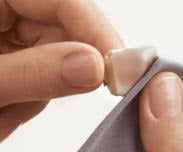 Ideally treat your hearing aids a little bit like your glasses, and give them a clean once a day.
Ideally treat your hearing aids a little bit like your glasses, and give them a clean once a day.
Some of our clients find that once a week or twice a week, is enough. But the majority of people, if they give their hearing aids a bit of a clean once a day, then that will really help prevent any build-up of wax or dirt or debris from occurring and then maybe blocking the hearing aids off completely and affecting your hearing.
Also, the longer that wax or dirt or debris are sat on the hearing aids, the greater the potential is for corrosion and whatnot, so giving them a little wipe - just the tip if it's an over-the-ear hearing aid. If it's an in-the-ear hearing aid, give them a little wipe with a tissue, especially the part that goes into the ear, is really good.
Tissue or microfibre cloth?
The hearing aid manufacturers much prefer we don't say (use a) tissue and tell you to use the little microfibre cloths that they give you, just because tissue can sometimes leave a little bit of dust on the microphones and things.
Personally, I find the tissues generally fine. Some of my clients make a very sticky wax. That means the tissue just doesn't work for cleaning the tips at all.
Using alcohol wipes
On the tip of the hearing aid, just the bit that goes in the ear, you can use some alcohol wipes.
Now, what we mean by alcohol wipes is actually the little swabs, the pre-injection swabs that you get in the chemist. They can be really good for that just giving the domes, or the tip of the hearing aid, a good clean.
Do not put that on the microphones of the hearing aids and definitely don't put it on the charging contacts because the alcohol can actually start to tear through that hydrophobic and philic layer that's on top of those charging components and the microphone, so be careful with that.
Domes
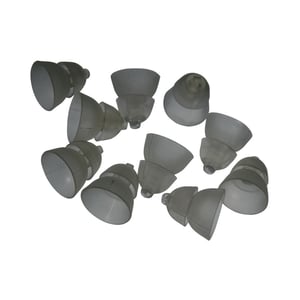 Also what you'll find is that the little dome that goes in your ear, if you've got an over-the-ear hearing aid, can wear out with time. Some manufacturers’ domes last a bit longer than others. Some people manage to get them going for years and have no problems. Others tear through them within a couple of months so it's really a case of just checking them.
Also what you'll find is that the little dome that goes in your ear, if you've got an over-the-ear hearing aid, can wear out with time. Some manufacturers’ domes last a bit longer than others. Some people manage to get them going for years and have no problems. Others tear through them within a couple of months so it's really a case of just checking them.
If they're loose, you don't want them coming off in your ear. It's best to replace them if you've been cleaning them a lot, say with alcohol wipes, as I've just recommended. You might find the domes start to disintegrate.
Some people even seem to have earwax or sweat that really manages to break down the silicone in the dome, so they fall apart a bit quicker with some than with others. Again, you’re best off to replace them.
When you get your hearing aids, most clinics will give you a massive stock - a good couple of years worth - of domes, so you should have plenty.
Wax Filter
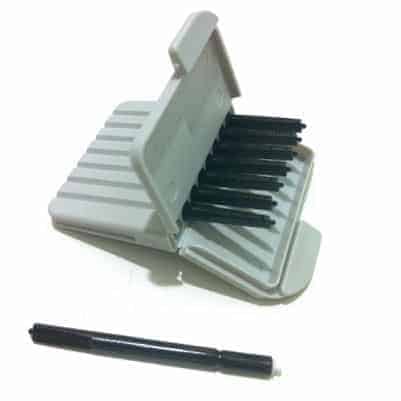 The other thing that needs to be done every now and again is changing the wax filter.
The other thing that needs to be done every now and again is changing the wax filter.
That exists in receiver-in-the-canal hearing aids and in the custom in-the-ear hearing aids . The whole purpose of the wax filter is that it literally acts like a little sink drainer. It sits there protecting the speaker and trapping any wax or skin, or debris and stopping it from getting into the speaker and breaking it down.
When it starts to build up, it can start to sound like you're just not hearing as loudly or as clearly. Then, when it closes off completely, it can sound like there's nothing coming from the hearing aid.
Clients will often ask us, ‘well, how often do I change the wax filter?’.
That's a tricky one because it's really personal. It's actually better to really assess the situation yourself. If you think, ‘I'm not hearing as well as normal’, then definitely change the wax filter. If you're not hearing at all, or it sounds like the hearing aid is broken down, again, change the wax filter.
If you're someone who seems to be changing wax filters a lot, you may need to look at wax management.
You may need to have it removed from the ear, or you may need to get into the habit of just wiping the outside of the ear, or you may just need to be one of those people that cleans their hearing aids every day, and that helps stop the build-up of wax on the tip itself. So, that is definitely something to check.
Wax management for behind-the-ear (BTE) hearing aids
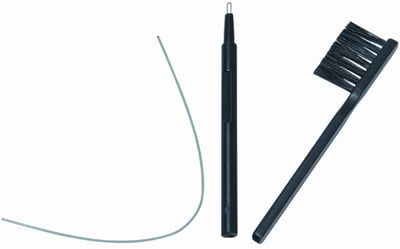 Now, with some hearing aids it isn't a speaker in the ear, it's actually a little tube that carries the sound into the ear. Some are thin tubes, some are thick tubes.
Now, with some hearing aids it isn't a speaker in the ear, it's actually a little tube that carries the sound into the ear. Some are thin tubes, some are thick tubes.
So with the thin tubes, when you get them from your audiologist, they should give you some little cleaning tools that look like a little wire that you can send through the tube and push out any debris and wax and whatnot that may have built up in there. Again, you can do that pre-emptively; more likely it'll be a case that if you're not hearing so well, or not hearing at all, you're best giving that tube a clean.
Those tubes also don't last that long. They last about six months. You'll notice when you first get them they're lovely and clear and then eventually they go kind of cloudy and you can't see them as clearly and that will really affect the clarity of the sound.
So, definitely change those little tubes at least every six months. Keep an eye on them and notice them changing.
The thick tubes, the more traditional tubes, that we have with some behind the ear hearing aids, tend to change colour but they also get quite hard, and that's often just exposure to heat and sunlight.
Again, generally every six months or so, they'll need to be changed and so it's quite important to keep an eye on that. Cleaning of those tubes is quite important.
Some of my clients use pipe cleaner to clean it. A lot of them will just run water through it - not too hot - but maybe lukewarm water. You can even use hand soap and whatnot. Rinse them out - when they're not attached to the hearing aids of course. Leave them to dry overnight and then reattach them to your hearing aids.
There are lots of little things you can do, depending on the type of hearing aid you have.
It's probably most important to read the instructions and the guidelines that the audiologist has given you.
You'll often hear audiologists say to clean every day, and you may not take it seriously, but it is a bit like maintaining your car, it is like cleaning your glasses. It's quite important to keep on top of it.
It's not possible to have a hearing aid in your ear all day every day and not have to have some maintenance, and all of this will really help keep the hearing aids going longer.
Humidity
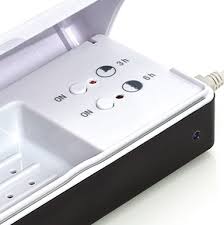 Now the other thing, especially here in a hot humid climate like Australia, we highly recommend the use of dry kits.
Now the other thing, especially here in a hot humid climate like Australia, we highly recommend the use of dry kits.
That's either a little box with desiccant in it, to try and absorb any moisture that may have built up in the hearing aid, or electronic devices that actually heat the hearing aids up a little bit and clean them with an ultraviolet light.
We find in Australia, hearing aids definitely last longer and have less breakdowns for clients that use those.
If you have one, use it. If you don't, consider purchasing one from your audiologist or online. It will make a big difference.
Rechargeable hearing aids can be a bit more tricky, so some of the manufacturers have desiccant built in and you're able to close the lid and it heats the hearing aids up.
Others don't have a lid or desiccant, or any way of drying them. With those clients, I often will ask them to still, maybe once or twice a week, use a different dry kit to put the hearing aids in. Not the charging kit, but another electronic kit and put the hearing aids in and give them a few hours to just run through the cycle of heating them up a little bit and absorbing any sort of moisture that may have built up.
Avoid moisture
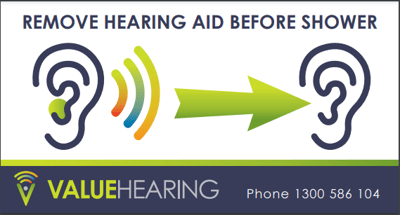 Another good tip is, obviously, in relation to that is not to go swimming with them, not to jump in the shower too often and forget to take them out.
Another good tip is, obviously, in relation to that is not to go swimming with them, not to jump in the shower too often and forget to take them out.
Look, if you do it a few times with today's modern hearing aids - most of them are an IP60 or 68 rating, meaning they're pretty dust and water resistant, more so for the over-the-ear models. The in-the ear models, not quite in most cases.
Ideally if it's in the ear, you never get in the shower.
Over the ear, try to avoid it. If you do a few times, like I said, you'll get away with it.
At Value Hearing we actually give all our clients a little sticker to put on their shower door to remind them not to get in the shower with their hearing aids. Whether it works or not, I'm not sure, because we get used to these things very quickly and you'll see that sticker and stop reading it.
But yes - it's definitely quite important to be cognisant of the fact that hot steamy showers and hearing aids- even when they're quite dust and water resistant - generally do not mix.
End of Warranty Servicing
Another good tip is, when you're coming towards the end of your warranty, is to send the hearing aids away for service. At Value Hearing, we call our clients back and say, ‘look, you're at your three or four year mark, depending on the manufacturer, and we need to send the hearing aids off for service just before you're going to be in a period where you would be charged for it’. That obviously helps a lot because you're getting brand new components and basically, the insides of the hearing aid will be completely changed and refreshed, and then you'll hopefully get another few years out of them.
So there you have it, that's the basics of looking after a hearing aid.
There's a few other things you can do, but those are the main ones.
What's almost non-negotiable if you want to really look after your hearing aids and really keep going as long, as possible - this is really what you should be doing.

